ANAPEN®
| Consumer Medicine Information (CMI) summary |
The full CMI on the next page has more details. If you are worried about using this medicine, speak to your doctor or pharmacist.
| 1. Why am I using ANAPEN®? |
ANAPEN® contains the active ingredient adrenaline (epinephrine). ANAPEN® is used for the immediate EMERGENCY TREATMENT of a SEVERE ALLERGIC REACTION (also known as ANAPHYLAXIS). For more information, see Section 1. Why am I using ANAPEN®? in the full CMI.
| 2. What should I know before I use ANAPEN®? |
It is important to know how to use an ANAPEN® BEFORE a severe allergic reaction causes a medical emergency. Ask your doctor or pharmacist how you can get an ANAPEN® Training Device for practice.
Do not use if you have ever had an allergic reaction to adrenaline (epinephrine) or any of the ingredients listed at the end of the CMI. Talk to your doctor if you have any other medical conditions, use any other medicines, or are pregnant or plan to become pregnant or are breastfeeding. For more information, see Section 2. What should I know before I use ANAPEN®? in the full CMI.
| 3. What if I am taking other medicines? |
Some medicines may interfere with ANAPEN® and affect how it works. A list of these medicines is in Section 3. What if I am taking other medicines? in the full CMI.
| 4. How do I use ANAPEN®? |
For single use only, please ensure you discard safely immediately after use. Inject into outer part of thigh. If necessary, you can use ANAPEN® through light clothing, such as denim, cotton or polyester. It is important to know how to use your ANAPEN® in an emergency. Read the instructions in the full CMI carefully. Always carry 2 units of auto-injectors in case the first administration fails or if one dose is not sufficient. More instructions can be found in Section 4. How do I use ANAPEN®? in the full CMI.
| 5. What should I know while using ANAPEN®? |
| Things you should do | Remind any doctor, dentist or pharmacist you visit that you are using adrenaline (epinephrine)
|
| Things you should not do |
|
| Driving or using machines | You should not drive or use machinery after injecting this medicine, since you may still be experiencing the effects of an anaphylactic shock. |
| Drinking alcohol | Alcohol may adversely affect this medicine by increasing the effects of this medicine. |
| Looking after your medicine | Keep the auto-injector in the outer carton in order to protect from light. Store below 25°C |
For more information, see Section 5. What should I know while using adrenaline (epinephrine)? in the full CMI.
| 6. Are there any side effects? |
Tell your doctor or pharmacist if you experience a fast or noticeable heartbeat, difficulty breathing, chest pain, shortness of breath. These are some common side effects that may be experienced. For more information, including what to do if you have any side effects, see Section 6. Are there any side effects? in the full CMI.
ANAPEN®
Active ingredient(s): adrenaline (epinephrine)
ANAPEN® Junior 150 - contains adrenaline (epinephrine) 150 micrograms/0.3mL
ANAPEN® 300 - contains adrenaline (epinephrine) 300 micrograms/0.3mL
ANAPEN® 500 - contains adrenaline (epinephrine) 500 micrograms/0.3mL
| Consumer Medicine Information (CMI) |
This leaflet provides important information about using ANAPEN®. You should also speak to your doctor or pharmacist if you would like further information or if you have any concerns or questions about using ANAPEN®.
Where to find information in this leaflet:
1. Why am I using ANAPEN®?
2. What should I know before I use ANAPEN®?
3. What if I am taking other medicines?
4. How do I use ANAPEN®?
5. What should I know while using ANAPEN®?
6. Are there any side effects?
7. Product details
| 1. Why am I using ANAPEN®? |
ANAPEN® contains the active ingredient adrenaline (epinephrine). Adrenaline belongs to the group of adrenergic and dopaminergic agents which are classified as cardiac stimulants. It is the medicinal product of choice to provide rapid relief of hypersensitivity reactions to allergies.
Adrenaline is a natural hormone released in response to stress. In acute allergic reactions it improves blood pressure, heart function and breathing, and reduces swelling. Adrenaline is also known as epinephrine.
ANAPEN® is used for the immediate EMERGENCY TREATMENT of a SEVERE ALLERGIC REACTION (also known as ANAPHYLAXIS) caused by peanuts or other foods, medicines, latex, insect bites or stings and other allergens.
ANAPEN® is intended for use in people who have been assessed and advised by their doctor or pharmacist as needing an ANAPEN® to treat their severe allergic reaction.
| 2. What should I know before I use ANAPEN®? |
ANAPEN® is a pre-filled syringe of adrenaline contained in an automatic injection device (Auto-Injector). This injects a single dose of adrenaline into muscle.
Talk to your doctor or pharmacist before using ANAPEN®.
- Your doctor should have carefully instructed you when to use and the correct way to use your ANAPEN® Auto-Injector.
- Anyone who has an episode of anaphylaxis should see their doctor about testing for substances they may be allergic to, so these can be strictly avoided in future. It is important to be aware that an allergy to one substance can lead to allergies to a number of related substances.
- If you have food allergies it is important to check the ingredients in everything you ingest (including medicines) as even small amounts can cause severe reactions
- Repeated local injection can result in skin damage at sites of injection.
- Accidental injection into a blood vessel may result in a sudden rise in blood pressure. Accidental injection into the hand or foot may result in loss of blood flow to the affected part. You should immediately seek medical advice.
Avoidance of known allergens is most important in preventing severe allergic reactions. A severe allergic reaction, otherwise known as anaphylaxis, is overwhelming and life-threatening. It affects the whole body, in particular the - heart and blood circulation.
This may cause, for example, low blood pressure and collapse, or abnormal heart beat or function.
- air passages and lungs.
This causes difficulty in breathing, with noisy wheezing or gasping, possibly with sneezing and a very runny nose.
- stomach and bowels.
This may cause nausea, vomiting, diarrhoea and abdominal cramps, often severe.
- skin (very common).
This causes flushing, itching, skin rash, hives or swelling, which may be widespread or in one part of the body.
- brain.
There may be fits or confusion due to lack of oxygen.
Usually several parts of the body are affected. The patient feels extremely unwell.
It is important to act quickly to treat a severe allergic reaction.
The adrenaline in ANAPEN® treats allergic emergencies. It
- shrinks abnormally wide blood vessels and
- makes the heart beat strongly.
This helps improve the very low blood pressure and poor circulation that occur in a severe allergic reaction.
Adrenaline also
- relaxes the lungs. This eases breathing and lessens wheezing.
- helps stop
- swelling, for example, of the face and lips
- skin rash and/or
- itching.
Warnings
Do not use ANAPEN® if:
- you are allergic to adrenaline (epinephrine), or any of the ingredients listed at the end of this leaflet.
- Always check the ingredients to make sure you can use this medicine.
Give WITH CAUTION to those who have:
- high blood pressure
- thyroid problems
- high pressure in the eye (narrow-angle glaucoma).
Take care also when giving ANAPEN® to those:
- having an anaesthetic
or who have: - diabetes
- heart disease
- allergy to ANAPEN®
- brain damage.
You should tell your doctor or pharmacist if you have:
- allergies to any other medicines, foods, preservatives or dye
- depression, or are on medication for depression
- thyroid problems, or are on thyroid medication
- heart disease, including angina or high blood pressure
- diabetes
- high pressure in the eye (narrow angle glaucoma)
- asthma
- are pregnant or planning to become pregnant
- ever had an allergic reaction to sodium metabisulfite.
- lowered potassium levels
- increased calcium in the blood
- Disorders of the blood circulation
- phaeochromocytoma (a type of tumour in the adrenal gland)
- kidney or prostate disease
During treatment, you may be at risk of developing certain side effects. It is important you understand these risks and how to monitor for them. See additional information under Section 6. Are there any side effects?
Pregnancy and breastfeeding
If you are pregnant or breast-feeding, think you may be pregnant or are planning to have a baby, ask your doctor or pharmacist for advice before taking this medicine.
- It is not clear whether taking adrenaline during pregnancy is of risk to the unborn child. This should not deter you if you are pregnant from using ANAPEN® in an emergency, as your life might be in danger. You should discuss this with your doctor before such an emergency occurs.
- Adrenaline is excreted in breast milk
| 3. What if I am taking other medicines? |
Tell your doctor or pharmacist if you are taking any other medicines, including any medicines, vitamins or supplements that you buy without a prescription from your pharmacy, supermarket or health food shop.
Some medicines may interfere with ANAPEN® and affect how it works. These include:
- Medicines for heart disease, such as digitals (digoxin), beta-blockers, quinidine
- Medicines for depression, such as tricylic antidepressants, mono amine oxidase inhibitors (MAOIs), serotonin and noradrenaline reuptake inhibitors (SNRIs)
- Medicines for diabetes, your doctor may change the dosage of your medication after using ANAPEN®
- Medicines for Parkinson's disease
- Medicines for thyroid disease
- Other Medicines: antihistamines such as diphenhydramine or chlorpheniramine, theophylline, ipratropium and oxitropium (used to treat airways disease including asthma), oxytocin (used in labour in pregnancy), inhaled anaesthetics, alpha adrenergic blockers (used to treat high blood pressure), sympathomimetics (used to treat asthma, other airways disease and nasal congestion).
These medicines may be affected by ANAPEN® or may affect how well it works. You may need different amounts of your medicines, or you may need to take different medicines.
Your doctor and pharmacist have more information on medicines to be careful with or avoid while taking this medicine.
Check with your doctor or pharmacist if you are not sure about what medicines, vitamins or supplements you are taking and if these affect ANAPEN®.
| 4. How do I use ANAPEN®? |
When to use ANAPEN®
The reaction usually starts within minutes of contact with the allergen and the person may experience:
- Itching of the skin, a raised urticarial rash (nettle rash), flushing and swelling of eyes, lips or tongue.
- Difficulty in breathing due to swelling of the throat. Wheezing, shortness of breath and coughing may result from tightening of the muscles in the lungs.
- Other symptoms of anaphylaxis including headache, vomiting and diarrhoea.
- Collapse and loss of consciousness due to a sudden lowering of blood pressure.
When you experience these signs and symptoms use the ANAPEN® Auto-Injector immediately. You must only inject this medicine into the muscle on the outer part of your thigh, not the buttock.
Sometimes a single dose of adrenaline may not be sufficient to completely reverse the effects of a serious allergic reaction. For this reason, your doctor is likely to prescribe more than one ANAPEN®for you. If your symptoms have not improved or have deteriorated within 5-15 minutes after the first injection, either you or the person with you should give a second injection. For this reason you should carry more than one ANAPEN®with you at all times.
In case of a second injection needed it is recommended to inject in the opposite thigh.
How much to use
For single use only, please ensure you discard safely immediately after use. ANAPEN®delivers one single dose of 0.3 mL liquid which is equal to 150/300/500 micrograms adrenaline. After use, a volume of 0.75 mL will remain in the auto-injector but this cannot be reused.
Use in adults
- The recommended dose is 300 micrograms for individuals under 60 kg bodyweight.
- For adults over 60 kg, the 300 micrograms dose may not be sufficient and these patients may need ANAPEN®500 micrograms in the autoinjector to reverse the effect of an allergic reaction.
- Larger adults may require more than one injection to reverse the effect of an allergic reaction.
Use in children: ANAPEN®500 micrograms is not recommended for use in children.
Use in children and adolescents
- The appropriate dose is 150 micrograms or 300 micrograms.
- This depends on the body weight of the child and the discretion of the doctor.
- An Auto-Injector that delivers 150 micrograms of adrenaline is also available. A dosage below 150 micrograms cannot be administered in sufficient accuracy in children weighing less than 15 kg and use is therefore not recommended unless in a life-threatening situation and under medical advice.
Children between 15 kg and 30 kg
The usual dose is 150 micrograms.
Children over 30 kg
The usual dose is 300 micrograms.
How to use ANAPEN®
- Always use this medicine exactly as your doctor has told you.
- Check with your doctor or pharmacist if you are not sure.
- Only inject into the thigh muscle.
Instructions for use
It is recommended that your family members, carers or teachers are also instructed in the correct use of ANAPEN®.
A Parts of the ANAPEN® Auto-injector:
Before you use your ANAPEN® Auto-Injector, you need to know about the parts of the Auto-Injector. These are shown in the picture below – Figure 1
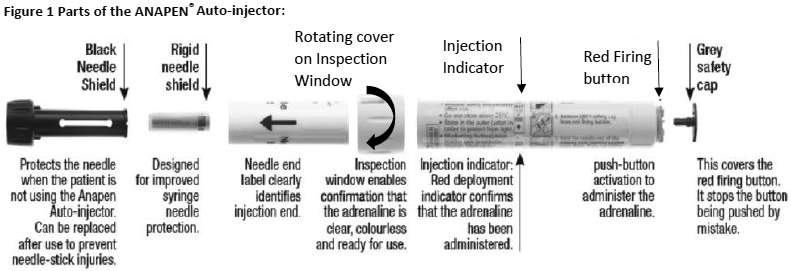
- Rotating cover over inspection window: You rotate the cover over the solution window to line up the lenses with the solution window on the Auto-Injector body.
- Inspection window: You look through the lens into this window before the injection to check that the solution is clear and ready to use.
- Injection indicator: Before the injection, you can see a white plastic plunger through the window. This means that the ANAPEN® Auto-Injector has not been fired by mistake or tampered with. After the injection, the injection indicator turns red. This indicates that the ANAPEN® Auto-Injector has been fired correctly.
- Black needle shield (reversible): This protects the needle when you are not using the ANAPEN® Auto-Injector. You pull the needle shield off before the injection. After the injection, turn the black needle shield around and put it back onto the same end of ANAPEN® Auto-Injector, to cover the needle.
- Grey safety cap: This covers the red firing button. It stops the button from being pushed by mistake.
Do not remove the black needle shield or the grey safety cap until you need to use your ANAPEN® Auto-Injector.
B. Checking your ANAPEN® Auto-Injector
Before you use your ANAPEN® Auto-Injector, and on a regular basis, you must check it as follows:
1. Rotate the cover over the solution window fully anticlockwise as indicated by the arrow to line up the lenses with the solution window on the auto-injector body.

2. Look through the lens into the solution window. Check that the solution is clear and colourless. If it is cloudy, coloured or contains particles, discard the ANAPEN® Auto-Injector.
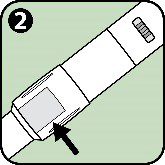
3. Make sure that the injection indicator is not red. If it is red, this means that the ANAPEN® Auto-Injector has already been fired and you must discard it.
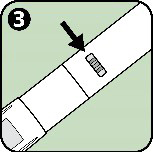
4. Rotate the cover over the solution window fully back clockwise as shown by the arrow, to ensure that the solution window is covered. Put the ANAPEN® Auto-Injector back in the carton until you need to use it.
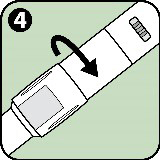
C. Using the ANAPEN® Auto-Injector
If the black needle shield has been removed, do not put your thumb, fingers or hand over the open end (needle end) of the ANAPEN® Auto-Injector.
To use the ANAPEN® Auto-Injector, follow the steps below:
1. Remove the black needle shield by pulling hard, in the direction of the arrow. This also removes an inner protective needle shield which is housed inside the rigid black needle shield.
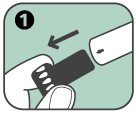
2. Remove the grey safety cap from the red firing button, by pulling as indicated by the arrow.
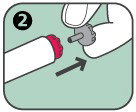
3. Hold the open end (needle end) of ANAPEN®against the outer part of your thigh. If necessary, you can use ANAPEN® through light clothing, such as denim, cotton or polyester.
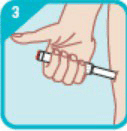
4. Press the red firing button so that it clicks. Keep holding the ANAPEN® Auto-Injector against your thigh for 3 seconds. Slowly remove ANAPEN® from your thigh.
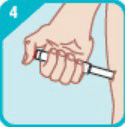
5. The injection indicator will have turned red. This shows that the injection is complete.
If the injection indicator is not red, you must repeat the injection with a new ANAPEN®.
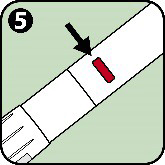
6. After the injection, the needle sticks out. To cover it, click the wide end of the black needle shield back on the open end (needle end) of ANAPEN® Auto-Injector (as indicated by the arrow).
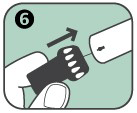
Help in using ANAPEN®
It is important to know how to use an ANAPEN® BEFORE a severe allergic reaction causes a medical emergency.
Ask your doctor or pharmacist how you can get an ANAPEN® Training Device for practice.
An ANAPEN® Training Device is similar to the real ANAPEN®. However, the ANAPEN® Training Device has
- NO medicine (adrenaline) and
- NO needle and
- “fires” quietly and less forcefully.
Ask your doctor or pharmacist to show you how to practice with the ANAPEN® Training Device. If you practice using the ANAPEN® Training Device, it will help you to learn how to use the real ANAPEN®.
It is important to regularly ask your doctor or pharmacist to demonstrate use with an ANAPEN® Training Device.
Please scan the QR code for access to Instructional video on website
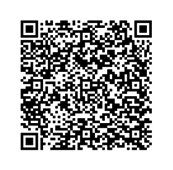
ANAPEN® is effective as emergency treatment of a severe allergic reaction ONLY when used according to the directions in this leaflet.
If you use too much ANAPEN®
Because each ANAPEN® contains only one dose, overdosage is unlikely. Overdosage may lead to a rise in blood pressure. This may cause bleeding in the brain or fluid in the lung.
If you think that you or anyone else may have used too much ANAPEN®, you may need urgent medical attention.
You should immediately:
- phone the Poisons Information Centre
(by calling 13 11 26), or - contact your doctor, or
- go to the Emergency Department at your nearest hospital.
You should do this even if there are no signs of discomfort or poisoning.
| 5. What should I know while using ANAPEN®? |
Things you should do
ANAPEN® is designed as emergency treatment. You should always get medical help immediately after using ANAPEN®. Dial 000; ask for an ambulance and state ‘anaphylaxis’ even if symptoms appear to be improving. You will need to go to hospital for observation and further treatment as required. This is because the reaction may happen again at some time later.
While waiting for the ambulance you should lie down with your legs raised unless this makes you breathless in which case you should sit up. Ask someone to stay with you until the ambulance arrives in case you feel unwell again.
Unconscious patients should be placed on their side in the recovery position.
Check what the expiry date is on your ANAPEN®. Mark this expiry date on your calendar or diary. Replace your ANAPEN® prior to this expiry date.
Also note on your calendar or diary to check the contents of your ANAPEN® each month. Do this through the “solution window” - refer to Figure 1.
Make sure the solution is clear, colourless and free of particles. If not, obtain a new ANAPEN® immediately.
If the “injection indicator” (refer to Figure 1) is red this means the ANAPEN® has already been “fired” or used. It cannot be used again. Return it to your doctor or pharmacist for disposal. Obtain a new ANAPEN® immediately.
The ANAPEN® Auto-Injector can be damaged and made unusable if it is mishandled.
ANAPEN® is NOT a toy. Keep it out of reach of children.
Things you should not do
Do not use ANAPEN® to treat any other complaints unless your doctor tells you to.
Do not give your medicine to anyone else, even if they have the same condition as you.
Do not use in children under 15 kg unless advised by your doctor.
Do not use if the solution is cloudy, coloured or contains particles.
Do not inject into hands, feet, ears, nose, buttocks, genital area or into a blood vessel.
If this does happen accidentally you must immediately seek medical attention. See Section 6. Are there any side effects?
Do not inject into the buttock.
Rare cases of serious skin infections have been reported following injection into the buttock. If you develop signs or symptoms of infection, such as persistent redness, warmth, swelling, or tenderness, at the adrenaline injection site you must seek medical attention immediately.
Driving or using machines
You should not drive or use machinery after injecting this medicine, since you may still be experiencing the effects of an anaphylactic shock.
Drinking alcohol
Tell your doctor if you drink alcohol.
Alcohol may adversely affect this medicine by increasing the effects of this medicine.
Looking after your medicine
Storage
Keep ANAPEN® available with the person for whom, it is intended.
Keep ANAPEN® in a cool dry place below 25°C. A temperature range between 15°C to 25°C is acceptable.
Keep the auto-injector in the outer carton in order to protect from light. Do not refrigerate or freeze. Store ANAPEN® lying down.
Do not leave ANAPEN® in your car. Extreme temperatures may cause the auto-injector unit to malfunction.
Do not use this medicine after the expiry date (Exp. Date) which is stated on the carton and the auto-injector. The expiry date refers to the last day of that month.
Discard and replace ANAPEN® after the expiry date. Check the solution regularly through the solution window to make sure the solution is clear, colourless and particle free.
Discard and replace ANAPEN® if the solution is cloudy, coloured or contains particles.
You should inspect your pen regularly as shown in the section on how to use ANAPEN® under the heading Instructions for use. This is to ensure ANAPEN® can be used in an emergency.
Keep it where young children cannot reach it.
When to discard your medicine (as relevant)
Do not dispose of any medicines via wastewater or household waste. Ask your pharmacist how to dispose of any unwanted medicines you no longer use. These measures will help protect the environment.
Give your used ANAPEN® to the hospital or pharmacist for proper disposal
The used ANAPEN® should be placed in a rigid sharps disposal unit.
Getting rid of any unwanted medicine
If you no longer need to use this medicine or it is out of date, take it to any pharmacy for safe disposal.
Do not use this medicine after the expiry date.
| 6. Are there any side effects? |
All medicines can have side effects. If you do experience any side effects, most of them are minor and temporary. However, some side effects may need medical attention.
See the information below and, if you need to, ask your doctor or pharmacist if you have any further questions about side effects.
Less serious side effects
| Less serious side effects | What to do |
Related to heart/chest
| Speak to your doctor if you have any of these less serious side effects and they worry you. These side effects are minor and short lasting. |
Serious side effects
| Serious side effects | What to do |
Heart/cardiovascular system
| Call your doctor straight away, or go straight to the Emergency Department at your nearest hospital if you notice any of these serious side effects. |
Tell your doctor or pharmacist if you notice anything else that may be making you feel unwell.
Accidental injection into the hands, fingers or feet may result in the following:
- fast or noticeable heart beat
- pale skin colour at the site of accidental injection
- feeling of coldness at the site of accidental injection
- bruising or discolouration at the site of accidental injection
- bleeding
If an accidental injection occurs at one of these areas, seek medical attention immediately.
Injection related injuries, such as needle cuts and bent needles, have been reported in people who are uncooperative and kick or move during the injection.
Sodium metabisulfite
ANAPEN® contains a very small quantity of sodium metabisulfite. In people who are allergic to sodium metabisulfite, this could cause, for example, severe asthma. However, the active ingredient, adrenaline, in ANAPEN® is expected to overcome any allergic reaction to sodium metabisulfite. In an emergency, the risk of exposure to the very small amount of sodium metabisulfite is generally outweighed by the benefits of ANAPEN®.
Other side effects not listed here may occur in some people.
Reporting side effects
After you have received medical advice for any side effects you experience, you can report side effects to the Therapeutic Goods Administration online at www.tga.gov.au/reporting-problems. By reporting side effects, you can help provide more information on the safety of this medicine.
Always make sure you speak to your doctor or pharmacist before you decide to stop taking any of your medicines.
| 7. Product details |
ANAPEN® may be prescribed by your doctor and is only available through a pharmacist.
What ANAPEN® contains
| Active ingredient (main ingredient) | adrenaline (epinephrine) |
| Other ingredients (inactive ingredients) |
|
| Potential allergens | Sodium metabisulfite |
Do not use this medicine if you are allergic to any of these ingredients.
What ANAPEN® looks like
ANAPEN® consists of a pre-filled syringe* of adrenaline solution for injection contained in an auto injection device (Auto-Injector). One dose of 0.3 mL contains 150/300/500 micrograms of adrenaline (epinephrine). ANAPEN® is a clear colourless solution free from visible particles.
ANAPEN® is supplied in packs of 1 or 2 auto-injectors with a thermoformed tray protection into the carton. Not all pack sizes may be marketed.
*Exposed needle length: 10 mm ± 1.5 mm.
ANAPEN® Junior 150 AUST R 337517
ANAPEN®300 AUST R 337512
ANAPEN®500 AUST R 337516
Who distributes ANAPEN®
ANAPEN® is supplied in Australia by:
Allergy Concepts
Suite 405, Level 4
83 York Street
Sydney NSW 2000
Ph: 1800761964
® = Registered Trademark
This leaflet was prepared in Oct 2022
Published by MIMS January 2023
